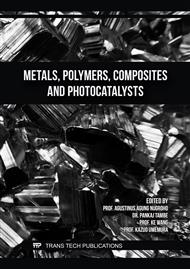[1]
Huang, Jing Yao, et al. "The Development of Modular Electrical Fittings for Transmission Lines in Intelligent Distribution Network." Applied Mechanics and Materials, vol. 325–326, Trans Tech Publications, Ltd., 13 June 2013, p.615–618. Crossref.
DOI: 10.4028/www.scientific.net/amm.325-326.615
Google Scholar
[2]
Niu, Hai Jun, et al. "Low Temperature Resistant Material Study of Fitting in Power Transmission Line." Advanced Materials Research, vol. 803, Trans Tech Publications, Ltd., Sept. 2013, p.247–252. Crossref.
DOI: 10.4028/www.scientific.net/amr.803.247
Google Scholar
[3]
QIAN C, ZHANG F, ZHANG L. The Optimal Control Method of Transmission Line Fittings Limits in Low Power Consumption State[J]. 2024.
Google Scholar
[4]
Haque S K M, Ardila-Rey J A, Umar Y, et al. Application and suitability of polymeric materials as insulators in electrical equipment[J]. Energies, 2021, 14(10): 2758.
DOI: 10.3390/en14102758
Google Scholar
[5]
Mi X, Liang N, Xu H, et al. Toughness and its mechanisms in epoxy resins[J]. Progress in Materials Science, 2022, 130: 100977.
DOI: 10.1016/j.pmatsci.2022.100977
Google Scholar
[6]
Rahman M M, Akhtarul Islam M. Application of epoxy resins in building materials: progress and prospects[J]. Polymer Bulletin, 2022, 79(3): 1949-1975.
DOI: 10.1007/s00289-021-03577-1
Google Scholar
[7]
Sarkar P, Modak N, Sahoo P. Effect of normal load and velocity on continuous sliding friction and wear behavior of woven glass fiber reinforced epoxy composite[J]. Materials Today: Proceedings, 2017, 4(2): 3082-3092.
DOI: 10.1016/j.matpr.2017.02.191
Google Scholar
[8]
Abenojar J, Tutor J, Ballesteros Y, et al. Erosion-wear, mechanical and thermal properties of silica filled epoxy nanocomposites[J]. Composites Part B: Engineering, 2017, 120: 42-53.
DOI: 10.1016/j.compositesb.2017.03.047
Google Scholar
[9]
Naito K. Interfacial mechanical properties of carbon/glass hybrid thermoplastic epoxy composite rods[J]. Composite Structures, 2021, 257: 113129.
DOI: 10.1016/j.compstruct.2020.113129
Google Scholar
[10]
PILLAYS, VAIDYA U K, JANOWSKI G M. Effects omoisture and UV exposure on liquid molded carbon fabric re.inforced nylon 6 composite laminates[J], Composites scieneeand technology,2009,69(6):839-846.
DOI: 10.1016/j.compscitech.2008.03.021
Google Scholar
[11]
Gao Y, Li C, Wang J, et al. Investigation on fatigue behavior and damage mechanism of C/BMI composites under hygrothermal environment[J]. Polymer Degradation and Stability, 2019, 169: 108989.
DOI: 10.1016/j.polymdegradstab.2019.108989
Google Scholar
[12]
Shi Z, Zou C, Zhou F, et al. Analysis of the mechanical properties and damage mechanism of carbon fiber/epoxy composites under UV aging[J]. Materials, 2022, 15(8): 2919.
DOI: 10.3390/ma15082919
Google Scholar



